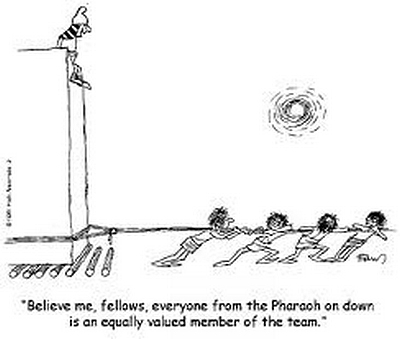ChangeAbility: How To Not Be An Annoying Leader
The Newsletter of Redpoint Coaching
Volume 9, No. 4, October 2010
Welcome!
We are proud to bring you the October issue of our ChangeAbility Newsletter published under our new brand, Redpoint Succession and Leadership Coaching. ChangeAbility provides you with hands-on tips and cool resources for growing your business and making you a better leader.
We welcome your responses, comments, and questions at changeability@redpointcoaching.com.
Best Regards,
Lauren and Urs
To subscribe or unsubscribe, go to the bottom of this message.
-----------------------------------------------------------------------------------------
IN THIS ISSUE:
-
The 22 Habits of Highly Annoying Leaders
-
How Redpoint Coaching Transforms Good Leaders Into Great Leaders (shameless promotion of why we think our process is one of the best in the business..)
-
Lauren and Urs' Personal Corner: The Most Fun I Had This Month Was...
-----------------------------------------------------------------------------------------
Want a friend or colleague to read ChangeAbility? Have them sign up
here
Thanks for your support!
++++ NO SPAM/PRIVACY STATEMENT ++++
We never sell or give away subscriber
info
-----------------------------------------------------------------------------------------
1. The 22 Habits of Highly Annoying Leaders
by Lauren Owen, MBA
 Peter Drucker, the renowned management consultant and writer, once wisely noted, “We spend a lot of time teaching leaders what to stop. Half the leaders I have met don’t need to learn what to do. They need to learn what to stop.”
Peter Drucker, the renowned management consultant and writer, once wisely noted, “We spend a lot of time teaching leaders what to stop. Half the leaders I have met don’t need to learn what to do. They need to learn what to stop.”
That’s the premise behind much of the leadership coaching work that Urs and I do. As Urs outlines in his column this month, we ask the people with whom our client works on a daily basis to identify specific behaviors that prevent the client from being an effective leader. We then work intensely with the client over a period of months to get them to change those behaviors.
We usually work with people who have already achieved some success in their careers and in leadership positions. They are experienced, skilled in their professions, savvy and smart. What, then, do we typically find are the top faults that hold them back?
With thanks to executive coach Marshall Goldsmith from his book, What Got You Here Won’t Get You There, here are the Top 20 workplace behaviors that separate the good from great leaders:
If any of the below sound familiar to you, the answer is simple. Take the list down to two or three issues and then stop doing them. However, as we all know simple does not always translate into easy! That’s where skilled coaching using a defined and focused process with lots of feedback can make all the difference to achieve effective change:
- Winning too much: The need to win at all costs. We’ve all known people who are terrific negotiators, so good that they leave a trail of ruined relationships once the deal is done.
- Adding too much value: If you’ve ever worked with someone who always has to have the last word, add a flourish or change to every idea, or turn every conversation into a “coaching” opportunity, you know how annoying this is.
- Passing judgment: The need to rate others and impose our standards on them.
- Making destructive comments: Do we believe ourselves to be sharp and witty or are we really being mean and destructive with needless sarcasm?
- Starting with “No, “But,” or “However”: Each of these words are “eraser” words. They erase everything you say before them, even if it was positive.
- Telling the world how smart we are: The need to show people how smart we are, all the time.
- Speaking when angry: Using anger as a management tool.
- Negativity: As in “Let me explain why that won’t work.”
- Withholding information: The refusal to share information to maintain advantage.
- Failing to give proper recognition. The inability to praise and reward.
- Claiming credit that we don’t deserve. Overestimating and feeling the urge to share our contribution to a project.
- Making excuses: the need to reposition our annoying behavior as a permanent fixture so people excuse us for it.
- Clinging to the past: The need to blame all of our negative behaviors and inability to change on past events.
- Playing favorites: Rewarding the people who only tell us what we want to hear.
- Refusing to express regret: Inability to take responsibility for our own actions and to express regret.
- Not listening: This is a huge issue for so many leaders. The same charisma and energy that creates opportunities for them prevents them from developing and valuing good listening abilities.
- Failing to express gratitude: These people can’t praise in public or in private.
- Punishing the messenger: Blaming the innocents who bring bad news.
- Passing the buck: The need to blame everyone but ourselves.
- An excessive need to be “me”: Exalting our faults as virtues because that’s simply “just who we are.”
We would add other behavioral issues to Marshall’s list, and they are:
- Lack of courage to confront bad behaviors in others: putting up with things we don't like because we can't bring ourselves to have the difficult conversation.
- Inability to delegate. The conviction that we are the only one who is capable of doing things right around the organization so we do it all (or try to.)
2. How Redpoint Coaching Transforms Good Leaders Into Great Leaders (shameless promotion of why we think our process is one of the best in the business)
By Urs Koenig, PhD, MBA
 A wealthy family wants to use its endowments to maximize the impact it makes on people’s lives. Think of Bill and Melinda forming the Bill and Melinda Gates Foundation.
A wealthy family wants to use its endowments to maximize the impact it makes on people’s lives. Think of Bill and Melinda forming the Bill and Melinda Gates Foundation.
A car company needs to translate insights from its research and development into actual improvements of their products on the road. Think Honda.
Individuals want to move from being motivated to change to making observable behavioral changes. Think weight loss programs such as WeightWatchers.
What is the link between desire or intention and successful results? You guessed it: It is the ‘How?’, or execution.
Lauren and I are huge proponents of the ‘how’ in business. We strongly believe that ‘how’ you conduct your business is almost as important as ‘what’ you actually do. We also subscribe to the notion that success often is 10 % in the idea and 90 % in the execution.
With this in mind, I want to share with you the ‘how’ of Redpoint’s leadership coaching. How do Lauren and I help good leaders become great leaders? By insisting on focus, measuring quantifiable results and involving key stakeholders. We require our coaching clients to select no more than three goals, then we continually measure progress toward those goals by surveying the people who work with these leaders. We are so confident in this process that we stake our own compensation on it (more on that later!)
Focus
 We help our clients become better bosses and better managers by improving what we call leadership behaviors. Specifically, that means identifying and addressing the interpersonal behaviors that are holding them back. For example, they might need to become better at delegating, soliciting input, holding people accountable or working across departments. Lauren and I don’t coach strategy, career or organizational change in our Leadership Coaching engagements; we coach behavior change.
We help our clients become better bosses and better managers by improving what we call leadership behaviors. Specifically, that means identifying and addressing the interpersonal behaviors that are holding them back. For example, they might need to become better at delegating, soliciting input, holding people accountable or working across departments. Lauren and I don’t coach strategy, career or organizational change in our Leadership Coaching engagements; we coach behavior change.
All the people we work with are extremely busy. We believe that one of the main reasons why people don’t always do what they understand they should be doing is over-commitment. I also know from trying to perfect my cross country ski racing form during many hours of video-taped sessions that at any one time we can really only focus on one specific thing to improve. We therefore make it a requirement that our clients focus on an absolute maximum of three specific leadership behaviors, one behavior at a time.
Make Results Quantifiable
 What gets measured gets managed (and done.) I am hard-pressed to find anyone who disagrees with this, yet very few coaches attempt to quantify the results of their work. I believe that far too much leadership development is (maybe purposefully) vague, not sufficiently applied and consequently difficult to quantify. I firmly believe that the 80/20 rule also applies to leadership development. That is, 80 percent of resolving a problem is getting the basics (i.e. 20 percent) right. By focusing on a maximum of three leadership behaviors and having stakeholders assess improvement informally and formally in surveys (see below), we make it straightforward to quantify our clients' progress.
What gets measured gets managed (and done.) I am hard-pressed to find anyone who disagrees with this, yet very few coaches attempt to quantify the results of their work. I believe that far too much leadership development is (maybe purposefully) vague, not sufficiently applied and consequently difficult to quantify. I firmly believe that the 80/20 rule also applies to leadership development. That is, 80 percent of resolving a problem is getting the basics (i.e. 20 percent) right. By focusing on a maximum of three leadership behaviors and having stakeholders assess improvement informally and formally in surveys (see below), we make it straightforward to quantify our clients' progress.
Halfway through and at the end of the engagement, the stakeholders formally evaluate their colleague/leader's progress using an anonymous mini 360-degree survey. The survey is very short and focuses only on the selected leadership behavior(s). The mini 360-degree survey assesses on a scale from -3 to +3, with -3 indicating the client has become less effective, 0 indicating no change and +3 more effective.
And here is the punch line we always enjoy adding: Lauren and I only get paid if the client actually improves--not in our opinion, not in the opinion of the client, but in the opinion of the people who really count, the stakeholders!
Involve The Right People
Who should determine if a leadership coaching engagement was a success? In most cases the success of leadership coaching (and a lot of training for that matter) is self-reported by either the client or the coach/trainer (or both). The client might gauge the success of the coaching work on how much she liked the coach and the coach might assess the success based on how much time he spent with the client. As my coaching repertoire, expertise and outlook evolve I have come to the conclusion that this widely-used approach is flawed.
The most important people (and the real clients!) in a coaching assignment are the people the client works with on a daily basis. They are the ones who need to gauge the client’s progress and assess at the end of the coaching assignment if the client has made the necessary changes.
Our coaching process therefore heavily involves what we call the client’s stakeholders. These 8-12 stakeholders are peers, direct reports, bosses, board members, suppliers, clients, government officials, or members of the community.
During the coaching engagement we make it a requirement that our clients follow up regularly (e.g. every 2- 4 weeks) with their stakeholders. Several studies, e.g. Morgan H. & Goldsmith M.: Leadership is a contact sport have shown that leaders are highly likely to achieve a measurable positive change in behavior if they consistently involve their colleagues in follow-up dialogs.
The regular informal follow-up is also important because of the ‘perception factor,’ that is, changing both the actual behavior and colleagues’ perceptions. There is no point in changing behavior if everyone is stuck in an old mindset and unable to register behavior changes. This regular follow-up also helps to shape perceptions among the client’s stakeholders.
So rather than a two-person process that involves mainly coach and client, we firmly believe in including stakeholders not only at the beginning and end but throughout the engagement since in many respects, the stakeholders are the real clients!
Do YOU Have What It Takes?

We only work with people who have guts and commitment. Our clients need guts because they need to be able to solicit frank feedback, admit their challenges, and demonstrate willingness to improve to the people they work with. They need commitment because there are no short cuts in our coaching. Like athletes in training, our clients need to be willing and able to put in time and effort if they want to see results.
3. Lauren and Urs' Personal Corner: The Most Fun I Had This Month Was...
 Our new column is our effort to celebrate the simple joys of having fun. Remember fun? You know, “lively, joyous play or playfulness: amusement, sport, recreation, etc.?" We challenge you to think about the most fun time you’ve had this month as well. And if you can’t remember the last time you did anything that fits the bill, we encourage you to get out there and recreate!
Our new column is our effort to celebrate the simple joys of having fun. Remember fun? You know, “lively, joyous play or playfulness: amusement, sport, recreation, etc.?" We challenge you to think about the most fun time you’ve had this month as well. And if you can’t remember the last time you did anything that fits the bill, we encourage you to get out there and recreate!
Lauren: The most fun I’ve had this month was...
in my weekly Zumba class. Is it a dance class? Is it a workout? I don’t care because it’s such a blast. I love Latin music, the hour flies by, I’m soaked in sweat and my classmates and I have big grins plastered on our faces. I could always buy a CD and do it at home but where’s the fun in that? (Plus, I’m pretty sure my two teenagers would be appalled if they ever saw me!)
Urs: The most fun I’ve had this month was...
taking my 5 year old son Luc on an overnight camping trip to Mt Rainier. Just he and I, the perfect father son weekend. We camped next to White River, cooked our dinner on a camp stove, enjoyed a campfire, washed our dishes and brushed our teeth in the river, snuggled in our sleeping bags, listened to the rain, had a great breakfast consisting of melted Swiss Chocolate and bread and then drove up to Sunrise for a hike. Thank you Luc, you made me a very happy Papi!
+++++LET
US KNOW WHAT YOU THINK+++++
Send an email to ChangeAbility@redpointcoaching.com.
We welcome your feedback!
ChangeAbility is a publication of Redpoint Succession and Leadership Coaching, which is run by Lauren Owen, MBA and Urs Koenig PhD, MBA.
Visit Redpoint's website: www.redpointcoaching.com, or call: ++ 1 206 372 8626
Copyright Redpoint Succession and Leadership Coaching, 2010. All rights reserved
To subscribe to this newsletter (to receive it via email), please visit our subscription page
|
Sign up for our e-newsletter ChangeAbility. ChangeAbility brings you hands-on tips and cool resources for growing your business. |
